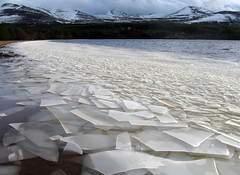Ice sheets are the largest potential source of future sea level rise ? and they also possess the largest uncertainty over their future behaviour

Those ice sheets again (Photo credit: swan-scot)
From the University of Bristol
Continuous satellite monitoring of ice sheets needed to better predict sea-level rise
The findings, published in Nature Geoscience, underscore the need for continuous satellite monitoring of the ice sheets to better identify and predict melting and the corresponding sea-level rise.
The ice sheets covering Antarctica and Greenland contain about 99.5 per cent of the Earth?s glacier ice which would raise global sea level by some 63m if it were to melt completely. The ice sheets are the largest potential source of future sea level rise ? and they also possess the largest uncertainty over their future behaviour. They present some unique challenges for predicting their future response using numerical modelling and, as a consequence, alternative approaches have been explored. One common approach is to extrapolate observed changes to estimate their contribution to sea level in the future.
Since 2002, the satellites of the Gravity Recovery and Climate Experiment (GRACE) detect tiny variations in Earth?s gravity field resulting from changes in mass distribution, including movement of ice into the oceans. Using these changes in gravity, the state of the ice sheets can be monitored at monthly intervals.
Dr Bert Wouters, currently a visiting researcher at the University of Colorado, said: ?In the course of the mission, it has become apparent that ice sheets are losing substantial amounts of ice ? about 300 billion tonnes each year ? and that the rate at which these losses occurs is increasing. Compared to the first few years of the GRACE mission, the ice sheets? contribution to sea level rise has almost doubled in recent years.?
Yet, there is no consensus among scientists about the cause of this recent increase in ice sheet mass loss observed by satellites. Beside anthropogenic warming, ice sheets are affected by many natural processes, such as multi-year fluctuations in the atmosphere (for example, shifting pressure systems in the North Atlantic, or El Ni?o and La Ni?a events) and slow changes in ocean currents.
?So, if observations span only a few years, such ?ice sheet weather? may show up as an apparent speed-up of ice loss which would cancel out once more observations become available,? Dr Wouters said.
The team of researchers compared nine years of satellite data from the GRACE mission with reconstructions of about 50 years of mass changes to the ice sheets. They found that the ability to accurately detect an accelerating trend in mass loss depends on the length of the record.
At the moment, the ice loss detected by the GRACE satellites is larger than what we would expect to see just from natural fluctuations, but the speed-up of ice loss over the last years is not.
The study suggests that although there may be almost enough satellite data to detect a speed-up in mass loss of the Antarctic ice sheet with a reasonable level of confidence, another ten years of satellite observations is needed to do so for Greenland. As a result, extrapolation of the current contribution to sea-level rise of the ice sheets to 2100 may be too high or low by as much as 35 cm. The study, therefore, urges caution in extrapolating current measurements to predict future sea-level rise.
###
=============================================================
The paper:
Limits in detecting acceleration of ice sheet mass loss due to climate variability
B. Wouters, J. L. Bamber, M. R. van den Broeke, J. T. M. Lenaerts & I. Sasgen
- Nature Geoscience (2013) doi:10.1038/ngeo1874
The Greenland and Antarctic ice sheets have been reported to be losing mass at accelerating rates1, 2. If sustained, this accelerating mass loss will result in a global mean sea-level rise by the year 2100 that is approximately 43?cm greater than if a linear trend is assumed2. However, at present there is no scientific consensus on whether these reported accelerations result from variability inherent to the ice-sheet?climate system, or reflect long-term changes and thus permit extrapolation to the future3. Here we compare mass loss trends and accelerations in satellite data collected between January 2003 and September 2012 from the Gravity Recovery and Climate Experiment to long-term mass balance time series from a regional surface mass balance model forced by re-analysis data. We find that the record length of spaceborne gravity observations is too short at present to meaningfully separate long-term accelerations from short-term ice sheet variability. We also find that the detection threshold of mass loss acceleration depends on record length: to detect an acceleration at an accuracy within ?10?Gt?yr?2, a period of 10 years or more of observations is required for Antarctica and about 20 years for Greenland. Therefore, climate variability adds uncertainty to extrapolations of future mass loss and sea-level rise, underscoring the need for continuous long-term satellite monitoring.
http://www.nature.com/ngeo/journal/vaop/ncurrent/full/ngeo1874.html
Related articles
Like this:
Loading...
new dark knight rises trailer khloe and lamar oklahoma city thunder sunoco titanic ii babe ruth new jersey nets
No comments:
Post a Comment
Note: Only a member of this blog may post a comment.